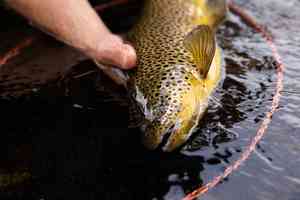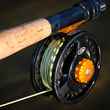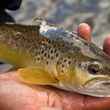If you grew up reading Patrick F. McManus in Field & Stream and Outdoor Life, you probably learned to fly fish with spools of 3X, 4X, 5X, and maybe 6X in your vest pockets. Then, one day, you went to the fly shop to replace a spool or two, and what on earth did you see? Half-sizes. If you were like me, you viewed this as the third sign of the Fly-Fishing Apocalypse. The first being nippers that cost more than a brake job. The second being Euro-nymphing.
As zippers on waders have proven, though, not all innovations are worthy of Walt Kowalski’s front-yard rant in Gran Torino. And I’m here to convince you that half-size tippets are worthy of your respect. To get there, I want you to think about how we hear.
Take a few seconds to hum the first three notes from the scale you learned in grade school.
Do-Re-Mi
If you’re one of those musical unicorns with perfect pitch and you started at middle C, you increased the frequency by 32 Hz when you moved from Do to Re. Then, when you climbed from Re to Mi, you went up by 36. These notes are burned into our memories because the changes from one note to the next sound and feel the same. But 32 and 36 are not equal, and they shouldn’t be. Want dogs to howl and parents to wince? Get a kid to make both jumps 32 Hz at their next recital.
The reason these unequal shifts sound and feel right is because the frequencies change by the same percent. Do-Re-Me starts at 262 Hz, jumps by 12.2 percent to 294, then jumps by 12.2 percent again to get to 330. Our ears care about percentages, much like our financial advisors do for inflation, interest, and market returns. So, the shifts sound the same. There’s a theory or law for everything, and this one is the Weber-Fechner Law.
Even if you’ve never called it by that name, you’ve known about it for most of your life. A five-pound bag of potatoes is half as heavy as a ten-pound bag. A ninety-five-pound Labrador retriever is hardly distinguishable from one that weighs a hundred. Both are five pounds lighter, but the potato sack cut its weight by fifty percent. The Lab, by only five.
So, what does this have to do with half-size tippet? The origin of the X scale for tippet is one of modern society’s unsolved mysteries. Up there with the number system for pencils, Caps Lock where Ctrl should be, and wiener dogs. Please, don’t send hate mail. I love wiener dogs. But, you have to admit, someone had fun making up the story of their origin. Flushing out badgers? Yeah, right.
The X size for tippet specifies its diameter in thousandths of an inch. In a sane world where high priests weren’t inventing languages to keep the unwashed out of the castle, a tippet whose diameter was 4 thousandths of an inch would have a 4 somewhere in its designation. One with a diameter of 6 thousandths of an inch would have a 6. But in our world, where a mile is 5,280 feet and 72 points make an inch, a tippet with a diameter of 4 thousandths of an inch is called 7X. One with a 6-thousandths-inch diameter is called 5X.
Fortunately, if your ciphering skills are adequate, you don’t need a Secret Society decoder ring to figure this out. The tippet’s X number tells you what to subtract from 11 to determine its diameter in thousandths of an inch. As a consequence of this unnecessary conversion, though, you have to use 10X for your size 46 gnat on the Henry’s Fork because, tragically, 11X can’t exist in this system.
To see the problem with our old standard, let’s think about the extremes first. The difference between 1X and 2X tippet looks like this:

You can see the difference, but one isn’t twice as wide as the other, like it is when we compare 9X to 10X:

For the thick stuff, 1X is about 11 percent thicker than 2X. For the thin stuff, 9X is 100 percent thicker than 10X. For wind resistance, pliability, and breaking strength, these differences are not the same. Switching by a single X designation depends on where you are on the scale. The standard transitions from 7X to 2X increase the diameter by 25, 20, 17, 14, and 13 percent for each transition.
So, how would we pick the sizes if we believed percentage changes mattered more than absolute ones? An equal temperament approach to tippet notes, so to speak.
Let’s use what we call 4X as our version of middle A, and keep its diameter at 7 hundredths of an inch. We’ll make the scale for our transitions 7 percent, so the next thickest tippet would be 7 percent larger, or 7.49 hundredths of an inch. If we convert that to its X number, we get roughly 3.5X. Going in the other direction, we get 6.54 hundredths, or approximately 4.5X. Sticking with X units for our tippet, our new scale from roughly 2X through 6X would be:
1.8X, 2.4X, 3.0X, 3.5X, 4.0X, 4.5X, 4.9X, 5.3X, 5.7X, 6.0X, and 6.3X
Not too different from 2X, 2.5X, 3X, 3.5X, 4X, 4.5X, 5X, 5.5X and 6X, is it? If we defined our scale with 8 percent changes, we’d get something similar in spirit:
1.5X, 2.2X, 2.8X, 3.4X, 4.0X, 4.5X, 5.0X, 5.4X, 5.9X, 6.2X, and 6.6X
Maybe they’re on to something. Perhaps the tippet manufacturers haven’t created the equivalent of cherry, vanilla, peach, mango, cinnamon, and coffee Coke. Maybe they’re just doing what should have been done long, long ago. So, go ahead, get yourself a tippet caddy wide enough for eight spools, and fill it up. And while you’re at the shop, check out those new 5.73 weight rods and lines. I hear they really sing.






























Comments
Jerry Dennis replied on Permalink
Brilliant! And a revelation. I have a hunch 5.5x will change my life. And I'm ordering that 5.73-weight rod right now.
Rick B. replied on Permalink
I had to check my calendar after reading this. You're only off by 129 days.
Rick B. replied on Permalink
I don't really see how you made the case for half-size tippets. The music analogy didn't work (for me). In my wildest imagination I cannot think of a single advantage that 6.5X has over 6X or 4.5X over 4X. Marketing hype for sure. Convincing unwitting fly anglers that these half sizes will help them catch more trout is a borderline scam.
The real scam is selling 7X, 8X, 9X, and 10X tippet.
Drag free, dry fly drifts can be accomplished with 4X or 3X in three ways 1) Better casting/aerial mending, 2) Better positioning, and 3) Longer tippets.
Using finer tippet sizes is just a crutch for those who struggle with casting and aerial mending, Yet any angler can choose the best position and extend tippet lengths to 4 to 5+ feet.
Euro/tight line anglers can get their Perdigons, PTNs, and all other nymphs down into the strike zone by using larger tungsten beads, adding an extra split shot, and using the Tuck cast. There is no reason to use any tippet finer than 4X.
Trout do see all of our tippets, regardless of diameter. So don't get sold on the visibility thing regarding tippet sizes that should be outlawed (7X - 10X).
Suggest giving this a read:
CHANGING YOUR MIND WHEN IT COMES TO TIPPET CHOICES
https://bucketlistangler.com/2134-2/
Jim Parks replied on Permalink
Rick, I totally agree with your 4x limit. I NEVER use anything smaller when I'm fishing for BIG wild trout in the Great Smoky Mountains National Park. I've caught trout up to 9 lbs on 4x with a 4wt rod short-lining the creeks and rivers. When water is dingy, I'll go to 3X and with streamers 2X.
Jim Parks
TailsOfThe Smokies
However, I will go down to 5 or 6x for smooth, clear tailwaters using tiny flies.
Rick B. replied on Permalink
Jim, I fish on tailwaters of the Upper Delaware system and rarely ever drop down to 5X. I think you would be surprised that you can be successful with small flies without ever dropping down to 6X. George Harvey insisted that he could successfully fish Tricos on 3X with his slack leader approach. The key is going with extra long tippet. I recommend reading the article I linked to. Good luck in the Smokies, sounds like quite an interesting system.
Matt replied on Permalink
Great points Rick. I seem to default to 5x tippet (I fish a lot of small waters with small bugs). I just haven't figured out how to cram a 4x tippet through the eye of a #18 BWO.
Kerry Gubits replied on Permalink
I live in Spain, and fish with the local anglers. X is unknown; they refer to tippet by hundredths of millimeters. For example, they fish with "14 or 12", 5X or 6X. In my home waters, the selective wild trout who live in buckets of still, clear water often won't touch your fly if it's tied on anything thicker than 9 one-hundredths of a millimeter. That's 8X.
Jon Conner replied on Permalink
It’s nice to see a rational argument, I’ve been using half sizes since I discovered Trout Hunter tippet many years ago, 4.5 and 5.5x are really good alternatives to having to make a full 1x step, Rene Harrup should be applauded for this innovation,
FML replied on Permalink
A Hatch article with without a single mention of climate change.
Chad Shmukler replied on Permalink
Jim Parks replied on Permalink
Regarding the "X' factor on tippet sizes. I read many years ago that line diameter was reduced by passing it through a diamond with a .011" hole drilled through it. Line would be passed through such diamonds multiple times, with each pass taking .001" off its diameter.
When line was passed through it once it was 1X or .010"
Passed through twice it was 2X or .009" and so on.
It's been probably 30 years since I read that, and I cannot remember the source.
Paul Sidener replied on Permalink
You said a lot, that isn’t convincing or relevant. My understanding is that the half sizes are because of tournament anglers, and euro nymphers have latched on to it. Those are both niches. The X system is so you can build a tapered leader. The X number is the industry standard. It has nothing to do with breaking strength. The average person fly fishing, doesn’t need to carry half size tippet. I carry 6X and 7X tippet. I will use 6X a couple times a year. I can’t tell you the last time I used 7X. I have been fly fishing most of my life. I can’t imagine a scenario where a half size tippet would have made a difference.
One of the knocks on fly fishing, is that you need a bunch of crap to do it. You don’t. My opinion is that this falls into that category. I got better when I simplified things and got rid of the crap, I didn’t need. This I don’t need.
Jim Parks replied on Permalink
I agree with Paul 100%!
Simplicity is the key!!
Jim
Jim Alberts replied on Permalink
Mr Schulz must have run out of worthwhile things to write about.
Pages